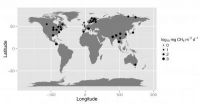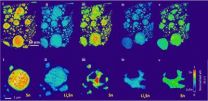(Press-News.org) Oxford, March 27, 2014 - A future computer might be a lot slimier than the solid silicon devices we have today. In a study published in the journal Materials Today, European researchers reveal details of logic units built using living slime molds, which might act as the building blocks for computing devices and sensors.
Andrew Adamatzky (University of the West of England, Bristol, UK) and Theresa Schubert (Bauhaus-University Weimar, Germany) have constructed logical circuits that exploit networks of interconnected slime mold tubes to process information.
One is more likely to find the slime mold Physarum polycephalum living somewhere dark and damp rather than in a computer science lab. In its "plasmodium" or vegetative state, the organism spans its environment with a network of tubes that absorb nutrients. The tubes also allow the organism to respond to light and changing environmental conditions that trigger the release of reproductive spores.
In earlier work, the team demonstrated that such a tube network could absorb and transport different colored dyes. They then fed it edible nutrients - oat flakes - to attract tube growth and common salt to repel them, so that they could grow a network with a particular structure. They then demonstrated how this system could mix two dyes to make a third color as an "output".
Using the dyes with magnetic nanoparticles and tiny fluorescent beads, allowed them to use the slime mold network as a biological "lab-on-a-chip" device. This represents a new way to build microfluidic devices for processing environmental or medical samples on the very small scale for testing and diagnostics, the work suggests. The extension to a much larger network of slime mold tubes could process nanoparticles and carry out sophisticated Boolean logic operations of the kind used by computer circuitry. The team has so far demonstrated that a slime mold network can carry out XOR or NOR Boolean operations. Chaining together arrays of such logic gates might allow a slime mold computer to carry out binary operations for computation.
"The slime mold based gates are non-electronic, simple and inexpensive, and several gates can be realized simultaneously at the sites where protoplasmic tubes merge," conclude Adamatzky and Schubert.
Are we entering the age of the biological computer? Stewart Bland, Editor of Materials Today, believes that "although more traditional electronic materials are here to stay, research such as this is helping to push and blur the boundaries of materials science, computer science and biology, and represents an exciting prospect for the future."
INFORMATION:
The research was undertaken in a framework of EU FP7 Project "Physarum Chip" (Unconventional Computing program).
Notes for Editors
This article is "Slime mold microfluidic logical gates" by Andrew Adamatzky and Theresa Schubert. It appears in Materials Today, Volume 17, Issue 2, March 2014, Pages 86–91 (2014) published by Elsevier. The article is available for free at http://www.materialstoday.com
About Materials Today
Materials Today is a community dedicated to the creation and sharing of materials science knowledge and experience. Supported by Elsevier, we publish high impact peer-reviewed journals, organize academic conferences, broadcast educational webinars and so much more.
The Materials Today journal is an Open Access journal, specializing in topical reviews, and covering the latest research, news, comment, and opinion in materials science.
About Elsevier
Elsevier is a world-leading provider of information solutions that enhance the performance of science, health, and technology professionals, empowering them to make better decisions, deliver better care, and sometimes make groundbreaking discoveries that advance the boundaries of knowledge and human progress. Elsevier provides web-based, digital solutions — among them ScienceDirect, Scopus, Elsevier Research Intelligence and ClinicalKey — and publishes nearly 2,200 journals, including The Lancet and Cell, and over 25,000 book titles, including a number of iconic reference works.
The company is part of Reed Elsevier Group PLC, a world-leading provider of professional information solutions in the Science, Medical, Legal and Risk and Business sectors, which is jointly owned by Reed Elsevier PLC and Reed Elsevier NV. The ticker symbols are REN (Euronext Amsterdam), REL (London Stock Exchange), RUK and ENL (New York Stock Exchange).
Media contact
Stewart Bland
Elsevier
+44 1865 843124
s.bland@elsevier.com
Computing with slime
Study published in journal Materials Today reveals details of logical circuits built using living slime molds
2014-03-27
ELSE PRESS RELEASES FROM THIS DATE:
Study finds gaming augments players' social lives
2014-03-27
New research finds that online social behavior isn't replacing offline social behavior in the gaming community. Instead, online gaming is expanding players' social lives. The study was done by researchers at North Carolina State University, York University and the University of Ontario Institute of Technology.
"Gamers aren't the antisocial basement-dwellers we see in pop culture stereotypes, they're highly social people," says Dr. Nick Taylor, an assistant professor of communication at NC State and lead author of a paper on the study. "This won't be a surprise to the ...
People unwilling to swallow soda tax, size restrictions
2014-03-27
ITHACA, N.Y. – Those hoping to dilute Americans' taste for soda, energy drinks, sweetened tea, and other sugary beverages should take their quest to school lunchrooms rather than legislative chambers, according to a recent study by media and health policy experts.
Soda taxes and beverage portion size restrictions were unpalatable to the 1,319 U.S. adults questioned in a fall 2012 survey as part of a study reported online this month in the journal Preventive Medicine.
Adding front-of-package nutrition labels and removing sugary beverages from school environments garnered ...
Agroforestry systems can repair degraded watersheds
2014-03-27
NAIROBI, Kenya. (27 March 2014) ----Agroforestry, combined with land and water management practices that increase agricultural productivity, can save watersheds from degradation.
A study conducted by the World Agroforestry Centre (ICRAF) in the Gabayan watershed in eastern Bohol, Philippines, has shown that agroforestry systems create a more sustainably managed watershed that allows people living there to benefit from the ecosystem. The benefits include higher crop yields, increased income and resilience to climate change.
Agroforestry is an integrated land-use management ...
Scientists watch nanoparticles grow
2014-03-27
This news release is available in German. With DESY's X-ray light source PETRA III, Danish scientists observed the growth of nanoparticles live. The study shows how tungsten oxide nanoparticles are forming from solution. These particles are used for example for smart windows, which become opaque at the flick of a switch, and they are also used in particular solar cells. The team around lead author Dr. Dipankar Saha from Århus University present their observations in the scientific journal Angewandte Chemie – International Edition.
For their investigation, the scientists ...
Record quantum entanglement of multiple dimensions
2014-03-27
The states in which elementary particles, such as photons, can be found have properties which are beyond common sense. Superpositions are produced, such as the possibility of being in two places at once, which defies intuition. In addition, when two particles are entangled a connection is generated: measuring the state of one (whether they are in one place or another, or spinning one way or another, for example) affects the state of the other particle instantly, no matter how far away from each other they are.
Scientists have spent years combining both properties to construct ...
A more potent greenhouse gas than CO2, methane emissions will leap as Earth warms
2014-03-27
While carbon dioxide is typically painted as the bad boy of greenhouse gases, methane is roughly 30 times more potent as a heat-trapping gas. New research in the journal Nature indicates that for each degree that the Earth's temperature rises, the amount of methane entering the atmosphere from microorganisms dwelling in lake sediment and freshwater wetlands — the primary sources of the gas — will increase several times. As temperatures rise, the relative increase of methane emissions will outpace that of carbon dioxide from these sources, the researchers report.
The findings ...
Researchers reveal the dynamics behind Arctic ecosystems
2014-03-27
Field studies covering three continents show that temperature has an unexpectedly important effect on food-web structure, while the relationship between predator and prey is crucial for the food-web dynamics and thereby the entire ecosystem.
Temperature is decisive
'We have gathered data on all animals and plants characterising the arctic tundra in seven different areas. This has allowed us to generate a picture of how food chains vary over a very large geographical (and, with it, climatic) gradient. Therefore, and for the first time, we can offer an explanation of ...
IRCM researchers uncover a new function for an important player in the immune response
2014-03-27
Montréal, March 27, 2014 – IRCM researchers led by Javier M. Di Noia, PhD, uncovered a new function of AID, a crucial enzyme for the immune response. The discovery, recently published by the scientific journal Proceedings of the National Academy of Sciences (PNAS), helps explain a rare genetic disorder that causes an immunodeficiency syndrome.
The Montréal research team studies the enzyme AID, or activation-induced deaminase, that can be found in B lymphocytes (the group of white blood cells whose main function is to produce antibodies to fight against infections). AID ...
Scientists track 3-D nanoscale changes in rechargeable battery material during operation
2014-03-27
UPTON, NY-Scientists at the U.S. Department of Energy's Brookhaven National Laboratory have made the first 3D observations of how the structure of a lithium-ion battery anode evolves at the nanoscale in a real battery cell as it discharges and recharges. The details of this research, described in a paper published in Angewandte Chemie, could point to new ways to engineer battery materials to increase the capacity and lifetime of rechargeable batteries.
"This work offers a direct way to look inside the electrochemical reaction of batteries at the nanoscale to better understand ...
Dentist shortage bites California as more choose to practice out of state
2014-03-27
A lingering recession, the elimination of Medicaid dental reimbursements and a glut of established dentists in wealthier, populated areas may explain why more new dentists are practicing outside California, according to a new policy brief from the UCLA Center for Health Policy Research.
"Good access to dental care depends on having a robust supply of new dentists in California," said Nadereh Pourat, director of research at the center and lead author of the study. "We need a new generation of dentists to replace the many dentists who are close to retirement." ...
LAST 30 PRESS RELEASES:
Making lighter work of calculating fluid and heat flow
Normalizing blood sugar can halve heart attack risk
Lowering blood sugar cuts heart attack risk in people with prediabetes
Study links genetic variants to risk of blinding eye disease in premature infants
Non-opioid ‘pain sponge’ therapy halts cartilage degeneration and relieves chronic pain
AI can pick up cultural values by mimicking how kids learn
China’s ecological redlines offer fast track to 30 x 30 global conservation goal
Invisible indoor threats: emerging household contaminants and their growing risks to human health
Adding antibody treatment to chemo boosts outcomes for children with rare cancer
Germline pathogenic variants among women without a history of breast cancer
Tanning beds triple melanoma risk, potentially causing broad DNA damage
Unique bond identified as key to viral infection speed
Indoor tanning makes youthful skin much older on a genetic level
Mouse model sheds new light on the causes and potential solutions to human GI problems linked to muscular dystrophy
The Journal of Nuclear Medicine ahead-of-print tip sheet: December 12, 2025
Smarter tools for peering into the microscopic world
Applications open for funding to conduct research in the Kinsey Institute archives
Global measure underestimates the severity of food insecurity
Child survivors of critical illness are missing out on timely follow up care
Risk-based vs annual breast cancer screening / the WISDOM randomized clinical trial
University of Toronto launches Electric Vehicle Innovation Ontario to accelerate advanced EV technologies and build Canada’s innovation advantage
Early relapse predicts poor outcomes in aggressive blood cancer
American College of Lifestyle Medicine applauds two CMS models aligned with lifestyle medicine practice and reimbursement
Clinical trial finds cannabis use not a barrier to quitting nicotine vaping
Supplemental nutrition assistance program policies and food insecurity
Switching immune cells to “night mode” could limit damage after a heart attack, study suggests
URI-based Global RIghts Project report spotlights continued troubling trends in worldwide inhumane treatment
Neutrophils are less aggressive at night, explaining why nighttime heart attacks cause less damage than daytime events
Menopausal hormone therapy may not pose breast cancer risk for women with BRCA mutations
Mobile health tool may improve quality of life for adolescent and young adult breast cancer survivors
[Press-News.org] Computing with slimeStudy published in journal Materials Today reveals details of logical circuits built using living slime molds




